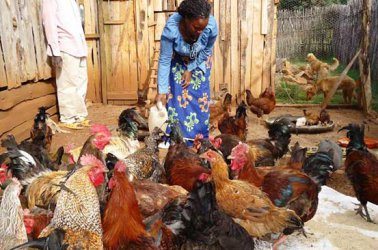Intensive systems of raising local chickens commercially is uncommon but due to the heavy demand for indigenous chickens in urban areas many farmers are now considering venturing into the practice. Extensive housing systems for poultry are the most common but management systems frequently overlap. For example free-range is sometimes coupled with feed supplementation, backyard with night confinement but without feeding, and poultry cages in confined spaces.
Free-Range Systems
Under this system, birds are not restricted and can search for food over a wide area. The flock contains birds of different types and different ages. Simple shelters are usually provided. Birds roost outside and nest in the bush.
Backyard Systems
This is the most common system in the rural areas. Birds are housed at night but allowed to roam freely during the day. Before release in the morning they are fed a small amount of feed usually maize grain. The same is repeated in the evening as supplement. Other feed types such as ugali leftovers can be included or thrown to them in the course of the day.
Semi-Intensive Systems
This is a combination of intensive and extensive systems where birds are restricted to a certain area with access to shelter. Birds are confined in an enclosed area outside during the day and provided with feed and water. A separate structure is provided where they are housed at night.

Improved local poultry house
Intensive Systems
These systems are used by medium to large-scale commercial enterprises, and are also used at the household level. Birds are fully confined either in houses or cages. Capital outlay is higher and the birds are totally dependent on their owners for all their requirements; production however is higher. There are three types of intensive systems:
- Deep litter system: birds are fully confined but can move around freely. The floor is covered with a deep litter of straw, wood shavings or other suitable material. The fully enclosed system is suitable for specially selected commercial breeds of egg or meat producing poultry.
- Slatted floor system: wire or wooden slatted floors are used instead of deep litter, which allow stocking rates to be increased. Birds have reduced contact with feces and are allowed some freedom of movement.
- Battery cage system: this is usually used for laying birds, which are kept throughout their productive life in cages. There is a high initial capital investment, and the system is mostly confined to large-scale commercial egg layer operations.
The consumption of poultry products in urban areas has grown and has created a great increase in demand. Local poultry has the potential to satisfy at least part of this demand through increased productivity and reduced wastage and losses, yet still represent essentially low-input production systems. For local poultry production to continue as a viable enterprise emphasis must be laid on selection and better management of stock health and local feed resources.
Appropriate new technologies basically determined by economic considerations can be introduced to improve the efficiency of local chicken in meeting urban demand. Genetic improvements through selection of superior birds and improved feed availability, health care and management would have a big effect on indigenous birds.








